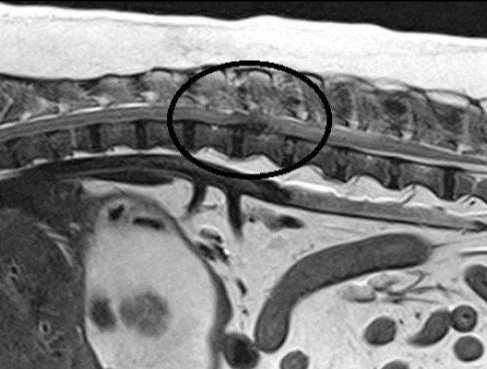IVDD - What is it?
- info476968
- May 26, 2023
- 3 min read
Intervertebral Disc Disease (IVDD) is a spinal cord condition that affects dogs, and it’s one of the most common spinal cord disorders seen in small breed dogs. This condition can cause severe pain, hind limb paralysis, or both, depending on the severity of the case. In some instances, it can lead to permanent disability or even death in some cases. Early identification and treatment are crucial in managing this condition. Therefore, this article seeks to provide insights on the diagnosis and treatment of IVDD in dogs.
Causes of IVDD in Dogs

IVDD is a degenerative spine disease that can be caused by various factors. One of the primary causes of this condition is the normal degeneration of the intervertebral discs that occur due to ageing. As dogs grow older, their intervertebral discs can harden and become less flexible, making them more susceptible to damage.
Other potential causes of IVDD may include injuries to the spine that can cause the discs to rupture or herniate. A sudden impact, twist, or fall can all cause damage to the spinal discs, leading to the onset of symptoms of IVDD in dogs.
Some breeds have a higher risk of developing IVDD than others. These breeds include the Dachshund, Beagle, Pekingese, Shih Tzu, Poodle, Basset Hound, and Welsh Corgi. These dogs have shorter legs and longer backs, which increase the stress on the spinal cord and put them at a higher risk of developing spinal cord injuries.
Diagnosing IVDD
Diagnosing IVDD requires a thorough physical exam of the dog by a veterinarian. The vet will examine the dog’s mobility, spinal reflexes, and muscle tone. They will also study the dog's medical history and review the symptoms that the owner has noticed.
Diagnostic imaging is the most reliable way to diagnose IVDD. X-rays and Magnetic Resonance Imaging (MRI) can be used to identify spinal cord compression and backup, nerve root compression, and sciatic nerve compression with higher accuracy. The severity of the disease can be assessed using these diagnostic modalities.
During diagnosis, it’s important to rule out other reasons that could be causing the same symptoms as those of IVDD. Some diseases can imitate the symptoms of IVDD, which include Osteosarcoma, Osteoarthritis, Degenerative Myelopathy, Spinal tumours, and Fibrocartilaginous Embolism.
How Can IVDD Be Treated?
The treatment option for IVDD is based on the severity of the condition. Treatment is classified into two categories, namely:
- Non-surgical Treatment
- Surgical Treatment

Non-Surgical Treatment
For mild cases of IVDD, the vet may recommend non-surgical treatment.
This treatment may include:
Rest
Dogs with mild IVDD symptoms can benefit from a couple of weeks of restricted movement. This can help to reduce inflammation, promote healing, and manage pain associated with IVDD.
Pain management
Painkillers and anti-inflammatory can be prescribed to manage the pain associated with IVDD. These medications may include non-steroidal anti-inflammatory drugs (NSAIDs), painkillers like tramadol, and muscle relaxants.
Rehabilitation
Some dogs may benefit from rehab programs that include physiotherapy, massage, and acupuncture. These therapies help to improve mobility and soft tissue function.
Surgical Treatment
Surgery is often recommended in severe cases of IVDD. Surgery can help to manage pain, restore mobility, and prevent permanent disability. The vet will advise the most suitable surgical treatment option that suits the specific case of the dog. Some of the common surgical procedures include:
Hemilaminectomy
This surgical procedure is often used to remove herniated or slipped discs from the dog’s spinal cord. The procedure involves the removal of a portion of the vertebral bone
Ventral Slot
This surgery is recommended for dogs that have a significant amount of spinal cord compression. A ventral slot procedure involves cutting through the underside of the neck to access the spinal cord and remove any tissue causing compression.
Discectomy
Discectomy involves the removal of part or all of the damaged disc. The vet will replace the damaged disc with a surgical implant or bone graft so that the spinal column is free from pressure.

Recovering From IVDD
The recovery period for dogs that undergo surgery can take several weeks or months. Immediately after surgery or treatment, the vet may prescribe postoperative care measures, including medication and rest to ensure proper healing. During this period, some dogs may also require physical therapy to regain mobility. They can then progress to hydrotherapy treatment, to aid this process and for maintenance further down the line to prevent further damage.

Early Intervention For IVDD
Early intervention plays a critical role in the management of IVDD in dogs. The sooner IVDD is diagnosed and treated, the better the chances of a good recovery. Early intervention allows the vet to prevent further damage to the spinal cord and helps to prevent the development of permanent disabilities. IVDD is a severe spinal cord condition and early intervention is crucial to your dogs recovery.




